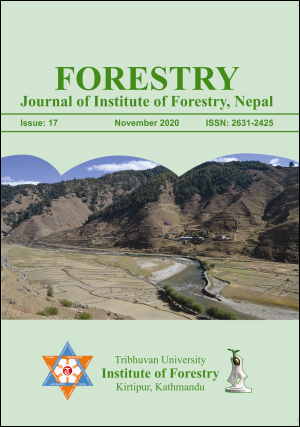Growing Season Vegetation Dynamics Based on NDVI and the Driving Forces in Nepal during 1982-2015
DOI:
https://doi.org/10.3126/forestry.v17i0.33619Keywords:
NDVI, growing season, climate, driving forces, NepalAbstract
Monitoring and attributing growing season vegetation dynamics have become crucial for maintaining the structure and function of the ecosystem. The objective of this research was to examine the spatial and temporal vegetation changes and explore their driving forces during growing season in Nepal. It also explored the variation of Normalized Difference Vegetation Index (NDVI) in different altitudes at each 100m interval. The National Oceanic and Atmospheric Administration (NOAA) NDVI, monthly temperature, precipitation and Shuttle Radar Topography Mission (SRTM) 90m Digital Elevation Model (DEM) were used. The linear regression model, Sen’s slope, Mann Kendall test and Pearson correlation between NDVI and climate, i.e., temperature and precipitation were computed. The driving forces were identified based on threshold segmentation method. Our results showed positive intensity of vegetation change. The NDVI has significantly increased at the rate of 0.001yr-1, 0.0005yr-1 and 0.002yr-1 in growing season, spring and autumn but it has insignificantly increased at the rate of 0.0003yr-1 in summer. In the meantime, growing season temperature has significantly increased with an average warming trend of 0.03°Cyr-1 but precipitation decreased at the rate of 2.76 mm yr-1 during 1982-2015. The NDVI increased in 84.20% (53.08% significant) of the area. The correlation between NDVI and temperature was found positive whereas correlation with precipitation was negative. Spatially, 84.05% of the study area found positive correlation between NDVI and temperature with 25.72% significance (p<0.05) which was very less with precipitation. Our results demonstrate that NDVI was strongly correlated with temperature compared with precipitation. Beyond the climate, NDVI changes were also attributed to multi-control environments and ecological restoration in Nepal.
Downloads
Downloads
Published
How to Cite
Issue
Section
License
© Tribhuvan University, Institute of Forestry




